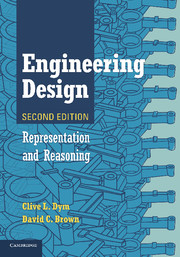Book contents
- Frontmatter
- Contents
- Preface
- Preface to the First Edition
- Acknowledgments
- 1 Framing the Issues
- 2 Engineering Design
- 3 Characterizing the Design Process
- 4 Taxonomies of Engineering Design
- 5 Representing Designed Artifacts
- 6 Representing Design Processes
- 7 Where Do We Go from Here?
- References Listed in First Edition
- New References
- Index
4 - Taxonomies of Engineering Design
Published online by Cambridge University Press: 05 June 2012
- Frontmatter
- Contents
- Preface
- Preface to the First Edition
- Acknowledgments
- 1 Framing the Issues
- 2 Engineering Design
- 3 Characterizing the Design Process
- 4 Taxonomies of Engineering Design
- 5 Representing Designed Artifacts
- 6 Representing Design Processes
- 7 Where Do We Go from Here?
- References Listed in First Edition
- New References
- Index
Summary
We have now defined, at least tentatively, what we mean by design, and we have described several views of the process of design. In so doing, we have identified some of the ways that problem-solving strategies could be employed in the design process. Now we turn to the task of trying to outline an organizational structure or taxonomy for design. According to the dictionary, a taxonomy is the result of the “study of the general principles of scientific classification” and a classification, at least in the natural sciences, is the “orderly classification of plants and animals according to their presumed natural relationships.” Similarly here, a taxonomy of design might (1) allow us to classify design problems according to certain characteristics; and (2) facilitate the organization of the knowledge, representation, and reasoning schemes that would be useful in modeling different kinds of design.
Are such taxonomies important? Why? One viewpoint is that a scientific theory of design cannot be developed without such a taxonomy. Another is that such taxonomies allow us to compare design methods and design tools – especially those reflecting the newer computer-aided technologies the ideas of which are reflected in this discussion. Our own viewpoint is stated somewhat differently in that we would stress any increase in our ability to understand and model the thought processes involved in design as being the best reason for developing such taxonomies. As we work toward this objective, we will simultaneously increase our abilities to compare various design tools and to develop and explore new design methods. We note also that, as with our characterizations of the design process, various taxonomies and classifications have been proposed, and there is certainly some overlap of ideas among them. After we review these various taxonomies, in an order roughly corresponding to their chronological development, we will try to analyze in a principled way what we have learned from so describing the thought processes of design.
- Type
- Chapter
- Information
- Engineering DesignRepresentation and Reasoning, pp. 39 - 68Publisher: Cambridge University PressPrint publication year: 2012



